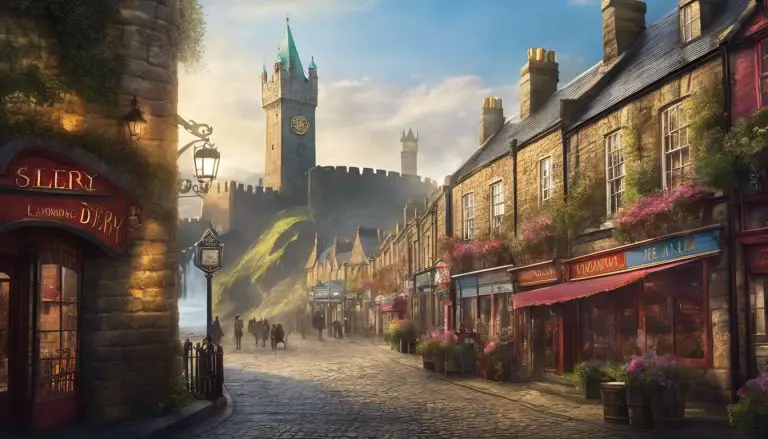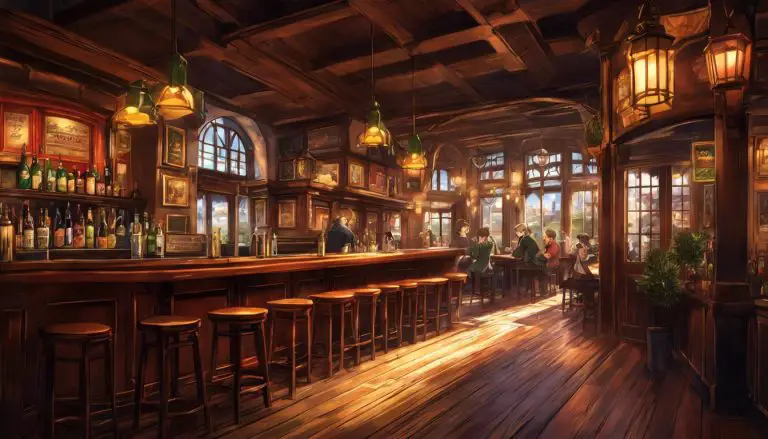What Does Bally Mean in Irish: Exploring the Origins and Significance
Have you ever seen the word “Bally” in Irish town names? Bally comes from the Gaelic phrase “Baile na,” meaning “place of.” This word connects to many spots in Ireland like Ballyjamesduff and Ballyreilly.
It shows up a lot as the start of these names. As time passed, people changed “Baile” to be easier for English speakers, making it “Bally.”.
“Bally” points us to old ways Irish folks named towns and lands. Some other starts for place names are Kil, Drum, and Carrick. Each part of a name tells something about the land or its story.
To truly get what each Bally means, we have to look close at history and language. The deeper meanings give clues about how people lived long ago. Come find out why these little words mean so much!
Key Takeaways
- Bally” is a prefix in Irish town names that means “place of” or “homestead,” from the Gaelic phrase “Baile na.
- Many Irish towns like Ballyjamesduff and Ballyreilly got their names because of this word, showing who lived there long ago.
- Other prefixes such as Kil/Kill, Drum/Drom, Carrick/Carrig/Carraig, and Cloch/Cloich/Clough/Clogh also tell us about places in Ireland.
- These words come from the old Irish language and they share stories about religion, hills, rocks, or stones in those areas.
- Understanding what “Bally” and other prefixes mean helps people learn more about Ireland’s past.
What Does Bally Mean in Irish?
Derived from the Gaelic phrase \\\”Baile na,\\\” bally means \\\”place of\\\” or \\\”homestead.\\\”
Meaning it holds significance as a prefix in many Irish town names.
Derived from the Gaelic phrase \”Baile na\”
“Bally” comes from the old Irish words that mean “place of.” In Ireland’s countryside, you will find many towns with names starting in “Bally.” These town names tell a story. They connect people to their land and history.
Each “Bally” is followed by the name of an important person or feature from long ago.
For example, Ballyjamesduff means James’s place, while Ballyreilly could be Reilly’s homestead. The prefix “Bally” helps us see what was significant about each area. It can point to who once lived there or what the land was like.
So when you hear a town name starting with “Bally,” it is whispering tales of Ireland’s past life and times.
Meaning \”place of\” or \”homestead\”
Derived from the Gaelic phrase “Baile na,” the term “Bally” in Irish often signifies “place of” or “homestead.” This common prefix is integral to town names across Ireland, demonstrating its cultural and historical significance.
The word’s origin from “Baile,” indicating homestead or town, emphasizes its roots in Irish language and heritage. As such, understanding the meaning of “Bally” sheds light on the linguistic and cultural tapestry of Irish place names, offering a glimpse into the country’s rich history and community development.
The Prevalence of Bally in Irish Town Names
Bally is a commonly used prefix in Irish town names, indicating a “place of” or “homestead.” It can be found in various town names such as Ballybunnion, Ballygibbon, and Ballyreilly.
Commonly used prefix in town names
Bally, derived from the Gaelic phrase “Baile na”, means “place of” or “homestead”.
- It is a prevalent prefix in Irish town names, such as Ballybunnion, Ballygibbon, and Ballyreilly.
- Other common prefixes in Irish town names include Kil/Kill, Drum/Drom, and Carrick/Carrig/Carraig.
- These prefixes indicate the features or history of a place and reflect the evolution of Irish place names.
- For example, Loughinisland, Templebar, and Lettermore demonstrate this evolution.
Examples: Ballybunnion, Ballygibbon, Ballyreilly
The Gaelic phrase “Baile na” gave rise to the common prefix “Bally” in Irish town names. This prefix can be seen in various town names across Ireland, each with its unique significance.
- Ballybunnion: The name originates from the Gaelic phrase “Baile an Bhuinneánaigh,” which translates to “town of the rivermouth.” It is a picturesque coastal town known for its natural beauty and historical significance.
- Ballygibbon: Derived from “Baile Uí Ghibheáin,” meaning “homestead of the Gibbons.” This town has a rich history dating back to ancient times and is associated with the prominent Gibbon family.
- Ballyreilly: The name comes from “Baile Ui Raghallaigh,” signifying “settlement of the O’Reillys.” It holds cultural and historical importance due to its connection with the O’Reilly clan and their legacy in the region.
Other Common Prefixes in Irish Town Names
Explore the significance of other common prefixes in Irish town names, such as Kil/Kill, Drum/Drom, Carrick/Carrig/Carraig, and Cloch/Cloich/Clough/Clogh. These prefixes also hold cultural and historical importance in understanding the origins of Irish place names.
Kil/Kill
The prefix “Kil/Kill” in Irish town names carries historical and cultural significance. It is commonly used to denote a church or a religious settlement. Here’s a breakdown of its relevance:
- “Kil/Kill” comes from the Gaelic word “Cill”, meaning church or religious community, reflecting the early Christian influence in Ireland.
- The prevalence of this prefix suggests the importance of religion in shaping Irish place names and communities.
- Examples include Kilkenny, derived from “Cill Chainnigh”, meaning Church of St. Canice, and Kildare, from “Cill Dara”, meaning Church of the Oak.
Drum/Drom
The prefix “Drum/Drom” in Irish town names signifies an area known for its rounded hills and ridges, derived from the Gaelic word “Drom”, meaning ridge or back.
- “Drum” is commonly used to denote a location near a ridge or rounded hill, highlighting the topographical features of the area.
- Examples include Drumshanbo in County Leitrim, where “Drum” reflects the town’s proximity to hilly terrain.
- The use of “Drom” in place names such as Dromahane in County Cork indicates the historical importance of ridges or backs within the community.
- When combined with other elements, such as “drumlin”, it reflects specific geographical aspects of the region.
- This prefix adds depth and context to Irish place names by encapsulating their surroundings and natural characteristics.
- An essential aspect of Irish culture, the prefix “Drum/Drom” preserves the historical and geographical identity of various locations across Ireland.
Carrick/Carrig/Carraig
The prefix “Carrick/Carrig/Carraig” is commonly used in Irish town names, indicating the presence of a rocky or stony landscape. This prefix signifies the geographical features of the area and reflects the historical significance of the town.
- The prefix “Carrick/Carrig/Carraig” is derived from the Gaelic word “Carraig”, meaning rock or rocky landscape. It denotes towns or areas with prominent rocky features.
- Towns bearing this prefix often have a connection to ancient geological formations, as seen in places like Carrick-on-Shannon and Carlingford.
- The prefix “Carrick/Carrig/Carraig” can also signify historic landmarks such as ancient stone fortifications or settlements built on rocky terrain.
- This prefix provides insight into the landscape and history of an area, shedding light on its geological composition and cultural heritage.
- Understanding the significance of “Carrick/Carrig/Carraig” in Irish town names enriches our appreciation for the diverse and meaningful origins of place names in Ireland.
Cloch/Cloich/Clough/Clogh
Moving on from the prefixes Carrick/Carrig/Carraig, let’s now explore the significance of Cloch/Cloich/Clough/Clogh in Irish place names:
- The prefix “Cloch” originates from the Gaelic word “cloich,” which translates to “stone” or “rock.”
- Towns and places with this prefix often have a historical connection to stone structures or prominent rock formations.
- The variation “Clough” also signifies a stony area or rocky landscape within the town or settlement.
- It is common for towns with this prefix to have historical landmarks made of stone, such as castles, forts, or ancient monuments.
- Additionally, the presence of rocky terrain or rocky outcrops in these areas influenced the naming with this particular prefix.
- The prefix “Cloch” reflects the rich history and geological features of the respective town or settlement.
- The use of “Cloch/Cloich/Clough/Clogh” in Irish place names showcases the significance of geology and historical stone structures in shaping local identities.
Evolution of Irish Place Names
Suffixes in Irish place names indicate the features or history of a place, showing the rich and evolving landscape of Ireland. Learn more about the origins and significance of Bally in Irish town names by diving into the fascinating world of Gaelic linguistics.
How suffixes indicate the features or history of a place
The addition of suffixes to Irish place names provides insight into the characteristics or historical significance of a location. For instance, the suffix “inis” in Loughinisland refers to an island within a lake, while “temple” in Templebar suggests the presence of a church or religious establishment.
Similarly, the term “letter” in Lettermore implies a hillside or elevated terrain. These suffixes offer valuable clues about the landscape and context of a particular place, enriching our understanding of Ireland’s geographical and cultural diversity.
Understanding how suffixes contribute to Irish place names enhances appreciation for the country’s history and topography. By decoding these linguistic elements, enthusiasts gain deeper insights into the features and heritage associated with different locations across Ireland.
Examples: Loughinisland, Templebar, Lettermore
Loughinisland, Templebar, and Lettermore are prime examples of how Irish place names have evolved to reflect the features or history of a place.
- Loughinisland combines “lough” for lake with the Irish word “inis” meaning island, reflecting its geographic location.
- Templebar refers to an area in Dublin, with “Temple” possibly denoting a Knights Templar presence and “Bar” often signifying an estuary or sandbank.
- Lettermore, derived from the Irish “Leitir Mór”, translates to “big hillside”, depicting the landscape it inhabits.
Conclusion
In conclusion, Bally in Irish means “place of” or “homestead” and is derived from the Gaelic phrase “Baile na.” It holds significant importance in the naming of towns and settlements in Ireland.
The evolution of Irish place names reflects the features or history of a place. This Gaelic word continues to shape and enrich the cultural landscape of urban and rural Ireland. Exploring its origins adds depth to our understanding of Celtic language origins.
FAQs
1. What does the word “Bally” mean in Irish?
“Bally” means a place or village, and it comes from the Irish word “Baile,” showing its origins in Celtic language.
2. How do you say “Bally” correctly in Irish?
To pronounce “Bally” correctly, think of the way you might say “bawl-y.” The pronunciation is similar to how you would say these English words.
3. Can I find the meaning of “Bally” in a dictionary?
Yes, if you look up “Bally” in an etymology dictionary, it will explain that this term has roots in ancient Celtic language and refers to an urban area or passage.
4. Why is knowing about “Bally” important when studying language origins?
Understanding words like “Bally,” which come from the old Irish term “Baile” or passageway terms like “Béal,” helps us see how languages evolve over time.







